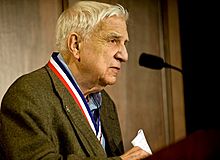Roger L. Easton facts for kids
Quick facts for kids
Roger L. Easton
|
|
|---|---|

Roger L. Easton at the National Inventors Hall of Fame. Source National Inventors Hall of Fame 2010
|
|
| Born | April 30, 1921 |
| Died | May 8, 2014 (aged 93) |
| Education | Middlebury College (bachelor's degree in physics) |
| Occupation | Scientist |
| Known for | Inventor and designer of the GPS |
Roger Lee Easton, Sr. (born April 30, 1921 – died May 8, 2014) was an American scientist. He is best known as one of the main inventors and designers of the Global Positioning System, or GPS. He worked on this important technology with Ivan A. Getting and Bradford Parkinson.
Contents
Building the GPS System
Roger Easton spent much of his career at the United States Naval Research Laboratory. He helped create many important space technologies.
Early Satellite Work
In 1955, Easton helped write a plan for the first U.S. satellite program, called Project Vanguard. This project was chosen by the government to launch America's first satellites.
In 1957, Easton invented the Minitrack system. This system helped track the Vanguard satellite's path in space. When the Soviet Union launched Sputnik I, the first artificial satellite, Easton improved Minitrack. It could then track any unknown object orbiting Earth.
Tracking Objects in Space
In 1959, Easton designed the Naval Space Surveillance (NAVSPASUR) system. This was the first system that could find and track all kinds of objects orbiting Earth. It covered a wide area across the United States.
Developing GPS Technology
Later, Easton came up with the main ideas for the Global Positioning System (GPS). He even got patents for his inventions.
During the 1960s and early 1970s, he developed a new way to navigate. It used very accurate clocks placed on satellites orbiting Earth. This system would send signals that could tell you your exact location and time on the ground.
To test his ideas, four experimental satellites were launched:
- TIMATION I (1967)
- TIMATION II (1969)
- Navigation Technology Satellite (NTS) 1 (1974)
- Navigation Technology Satellite (NTS) 2 (1977)
NTS-2 was a very important satellite because it was the first to send out GPS signals.
About Roger Easton
Roger Easton was born on April 30, 1921, in Craftsbury, Vermont. His father was a doctor, and his mother was a teacher.
Education and Early Career
Easton studied physics at Middlebury College and finished his degree in 1943. He also studied for a short time at the University of Michigan.
In 1943, he joined the United States Naval Research Laboratory. There, he worked on radar systems and helped develop blind-landing systems for aircraft. He also worked on rockets and space research.
Easton retired from his work in 1980. He passed away on May 8, 2014, at 93 years old.
Awards and Honors
Roger Easton received many important awards for his work on GPS and space technology.
National Recognition
In 2006, President George W. Bush gave Easton the National Medal of Technology. This is the highest award for technology in the United States. He received it for his amazing work in tracking spacecraft, navigation, and timing technology, which led to GPS.
On March 31, 2010, Easton was added to the National Inventors Hall of Fame. He was honored for his TIMed navigATION (TIMATION) system. This system was a key part of GPS because it provided accurate location and precise time.
Other Awards
Throughout his career, Easton received many other honors:
- The Distinguished Civilian Service Award (1960)
- The Institute of Navigation's Colonel Thomas L. Thurlow Navigation Award (1978)
- The Naval Space Surveillance Center created the Roger L. Easton Science and Engineering Award in his honor (1991)
- He was inducted into the GPS Hall of Fame (1996)
- He received the Magellanic Premium (1997)
- He was given the 12th Sheikh Salam Al-Ali Al-Sabah Informatics Badge of Honour from Kuwait for being the "Prime Inventor of GPS" (2013)

